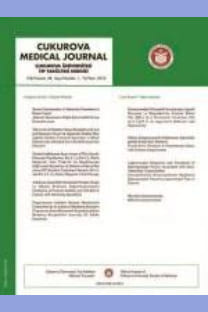COVID-19'un santral sinir sistemi tutulumunu değerlendirmek için bir araç olarak manyetik rezonans görüntülemenin etkinliği
Covid-19, konfüzyon, santral sinir sistemi, MRI.
Efficacy of magnetic resonance imaging as a tool to assess central nervous system involvement of COVID-19
Covid-19, confusion, central nervous system, MRI.,
___
- 1. Gupta A, Madhavan MV, Sehgal K, Nair N, Mahajan S, Sehrawat TS, Bikdeli B, Ahluwalia N, Ausiello JC, Wan EY, Freedberg DE. Extrapulmonary manifestations of COVID-19. Nature medicine. 2020;26:1017-32.
- 2. Zubair AS, McAlpine LS, Gardin T, Farhadian S, Kuruvilla DE, Spudich S. Neuropathogenesis and neurologic manifestations of the coronaviruses in the age of coronavirus disease 2019: a review. JAMA neurology. 2020;77:1018-27.
- 3. M.A. Ellul, L. Benjamin, B. Singh, S. Lant, B.D. Michael, A. Easton, R. Kneen, S. Defres, J. Sejvar, T. Solomon, Neurological associations of COVID-19, Lancet Neurol. (2020).
- 4. Meinhardt J, Radke J, Dittmayer C, et al. Olfactory transmucosal SARS-CoV-2 invasion as a port of central nervous system entry in individuals with COVID-19. Nat Neurosci. 2021;24:168-175.
- 5. Cooper KW, Brann DH, Farruggia MC, Bhutani S, Pellegrino R, Tsukahara T, Weinreb C, Joseph PV, Larson ED, Parma V, Albers MW. COVID-19 and the chemical senses: supporting players take center stage. Neuron. 2020;107:219-33.
- 6. Paniz‐Mondolfi A, Bryce C, Grimes Z, Gordon RE, Reidy J, Lednicky J, Sordillo EM, Fowkes M. Central nervous system involvement by severe acute respiratory syndrome coronavirus‐2 (SARS‐CoV‐2). Journal of medical virology. 2020;92:699-702.
- 7. Reichard RR, Kashani KB, Boire NA, Constantopoulos E, Guo Y, Lucchinetti CF. Neuropathology of COVID-19: a spectrum of vascular and acute disseminated encephalomyelitis (ADEM)-like pathology. Acta neuropathologica. 2020;140:1-6.
- 8. Mehta P, McAuley DF, Brown M, Sanchez E, Tattersall RS, Manson JJ. HLH across speciality collaboration, UK COVID-19: consider cytokine storm syndromes and immunosuppression. Lancet 2020; 395:1033–1034.
- 9. JainR, YoungM,Dogra S, et al. COVID-19 related neuroimaging findings: a signal of thromboembolic complications and a strong prognostic marker of poor patient outcome. J Neurol Sci 2020;414:116-923.
- 10. Radmanesh A, Raz E, Zan E, et al. Brain imaging use and findings in COVID-19: a single academic center experience in the epicenter of disease in the United States. AJNR Am J Neuroradiol 2020;41:1179–83
- 11. Oxley TJ, Mocco J, Majidi S, et al. Large-vessel stroke as a presenting feature of COVID-19 in the young. N Engl J Med 2020;382:e60
- 12. Bikdeli B, Madhavan MV, Jimenez D, et al; Global COVID-19 Thrombosis Collaborative Group, Endorsed by the ISTH, NATF, ESVM, and the IUA, Supported by the ESC Working Group on Pulmonary Circulation and Right Ventricular Function. COVID-19 and thrombotic or thromboembolic disease: implications for prevention, antithrombotic therapy, and follow-up: JACC state-of-theart review. J Am Coll Cardiol 2020;75:2950–73
- 13. Glass WG, Subbarao K, Murphy B, Murphy PM. Mechanisms of host defense following severe acute respiratory syndrome-coronavirus (SARS-CoV) pulmonary infection of mice. J Immunol. 2004;173:4030–9.
- 14. Chen N, Zhou M, Dong X, Qu J, Gong F, Han Y, Qiu Y, Wang J, Liu Y, Wei Y, et al. Epidemiological and clinical characteristics of 99 cases of 2019 novel coronavirus pneumonia in Wuhan, China: a descriptive study. Lancet. 2020;395:507–13.
- 15. Wang D, Hu B, Hu C, Zhu F, Liu X, Zhang J, Wang B, Xiang H, Cheng Z, Xiong Y, et al. Clinical characteristics of 138 hospitalized patients with 2019 novel coronavirus-infected pneumonia in Wuhan, China. Jama. 2020;323:1061–9.
- 16. Cai H. Sex difference and smoking predisposition in patients with COVID-19.Lancet Respir Med. 2020;8:e20.
- 17. Zhao Y, Zhao Z, Wang Y, Zhou Y, Ma Y, Zuo W. Single-cell RNA expression profiling of ACE2, the putative receptor of Wuhan 2019-nCov. biorxiv. 2020 Jan 1.
- 18. Koeller KK, Shih RY. Viral and Prion Infections of the Central Nervous System: Radiologic-Pathologic Correlation: From the Radiologic Pathology Archives. Radio-Graphics 2017;37:199–233.
- 19. Kelley BP, Patel SC, Marin HL, Corrigan JJ, Mitsias PD, Griffith B. Autoimmune Encephalitis: Pathophysiology and Imaging Review of an Overlooked Diagnosis. AJNR Am J Neuroradiol 2017;38:1070–1078.
- 20. Helms J, Kremer S, Merdji H, Clere-Jehl R, Schenck M, Kummerlen C, Collange O, Boulay C, Fafi-Kremer S, Ohana M, Anheim M. Neurologic features in severe SARS-CoV-2 infection. New England Journal of Medicine. 2020;382:2268-70.
- ISSN: 2602-3032
- Yayın Aralığı: 4
- Başlangıç: 1976
- Yayıncı: Çukurova Üniversitesi Tıp Fakültesi
Mehmet GÜMÜŞ, Mustafa KALE, Soner ÇAKMAK
Post-COVID kortikosteroid kullanımı ve pulmoner fibrozis: 1 yıllık izlem
Efraim GÜZEL, Oya BAYDAR TOPRAK
Sami AKBULUT, Zeynep KÜÇÜKAKÇALI, Cemil ÇOLAK
Saf torasik spinal epidural kavernöz hemanjiom (SEKH)
Özkan ÖZGER, Necati KAPLAN, Altay Tolga ŞENTÜRK
Ayşe Nur TOPUZ, Nafiz BOZDEMİR
COVID-19 vakalarında DNA hasarı ve enflamasyon
Selen ACEHAN, Salim SATAR, Müge GÜLEN, Başak TOPTAŞ FIRAT, Deniz Aka SATAR, Adnan TAŞ
Yaşlı yetişkinlerde osteoporoz tedavisinde antirezorptif ajanların karşılaştırılması
Eyyüp Murat EFENDİOĞLU, Ahmet ÇİĞİLOĞLU, Sencer GANİDAĞLI, Zeynel Abidin ÖZTÜRK
COVID-19 pandemisinde beyin ölümü tanısı ve yönetimi
Hamide Ayben KORKMAZ, Buket ÖZYAPRAK, Ayşe Neslihan BALKAYA, Asiye DEMİREL, Nermin KILIÇARSLAN, Canan YILMAZ
